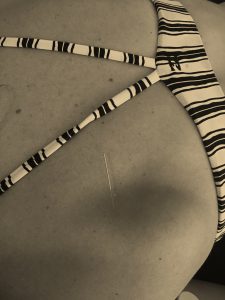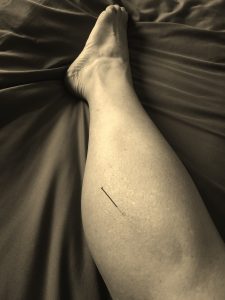DRY NEEDLING…..What it is & how it could help your injury & pain
WHAT IS DN & HOW IS IT DIFFERENT TO ACUPUNTURE?
A thin filiform needle is inserted into a trigger point , connective tissue or fascia and is used alongside other forms of physiotherapy to promote pain relief, reduce stiffness and facilitate range of movement and function. It’s has been use since the 1980’s but recently become very popular.
ACUPUNTURE is a similar concept of needling but can be seen as more holistic, looking at the body’s state of energy flow and meridians. Acupuncture focuses on fixed points where as DN targets more specific muscle pain points. The therpapist will palate and find these pain / tight spots.
The areas of muscle pain are known as myofascial trigger points. Muscles can have one or several points. They are seen as hyper irritable spots in skeletal muscle that are associated with hypersensitive palpable nodules in taut bands…. That knot you feel in your upper shoulders most of you will be familiar with?!
Often these trigger points will REFER PAIN , so we may put needles in quite far away from where you will be perceiveing your pain. BACK & SCIATIC pain would be a good example of this…… Often needling would be used around the back for pain that is felt down into the leg.
Studies have shown 30-85% of people presenting to a clinic are found to have myofascial trigger points to be the cause of their pain!

WHAT ARE THE EFFECTS?
By inserting a needle into these taut bands / trigger points we are aiming to re set the muscle and help reduce the referred pain. A local response of redness , swelling , heat and pain such as seen in an inflammatory reaction will be elicited – briefly this will stimulate the good chemicals to be released and begin to reverse the ischemic (or toxic like) effects which commonly occur with injury. This may help REDUCE PAIN, INCREASE ROM, MOBILITY and FUNCTION

WHY SHOULD YOU TRY IT?
For all the reasons listed above! It is another modality that can be used alone or in conjunction with other physio techniques which may help facilitate your healing, or better allow you to access a movement pattern/range of movement you have been struggling with. Also the many ways needling can act on the body in terms of pain relief, it may benefit you where perhaps other treatments no longer have such a desired effect. It can also be a very quick procedure so ideal in sports settings.
WHAT WILL YOU FEEL?
there are various sizes of needles and the therapist will choose one depending on the muscle and each individual . Treatment is often pain free but it is common to feel a ‘twitch response’ . The needle can be manipulated to further stimulate the fascia and muscle tissue to produce a local stretch response. Keeping it brief needling works on pain at different levels within the body ( locally, within the spinal cord and the higher ‘brain centers’ ) but overall has been seen to facilitate opioid release and pain modulate.
Everybody’s experience is different but often when needling the lower limb patients report a feeling of lightness. It’s also quite common to feel a dull ache following treatment
Below is a nice example of how fine the needles are – nothing to be afraid of!:

DEEP (trigger points) VERSUS SUPERFICIAL (pain relief)NEEDLING:
superficial needling uses needles that are much smaller and don’t penetrate more than 1cm, but are often left in for up to 15 mins. Where as deep needling uses needles up to 125mm treatment normally lasts for a couple of mins.
superficial DN:
– reduced local & referred pain ( activates mechanorecptors coupled to C fibers)
– increased ROM ( stretching in fibroblasts within connective tissue/ fascia)
– if stimulating skin according to hiltons law you the same nerve will innervate the muscle directly below, so potentially have an overall greater effect
deep DN:
– local twitch response ( targeted at specific muscle )
– reduction of noxious inflammatory immune related chemicals
– resetting and reduction of pain within a muscle
– overall increased ROM, decreased pain and increased function
If you would like to know if needling can help you with an injury be sure to get in touch!